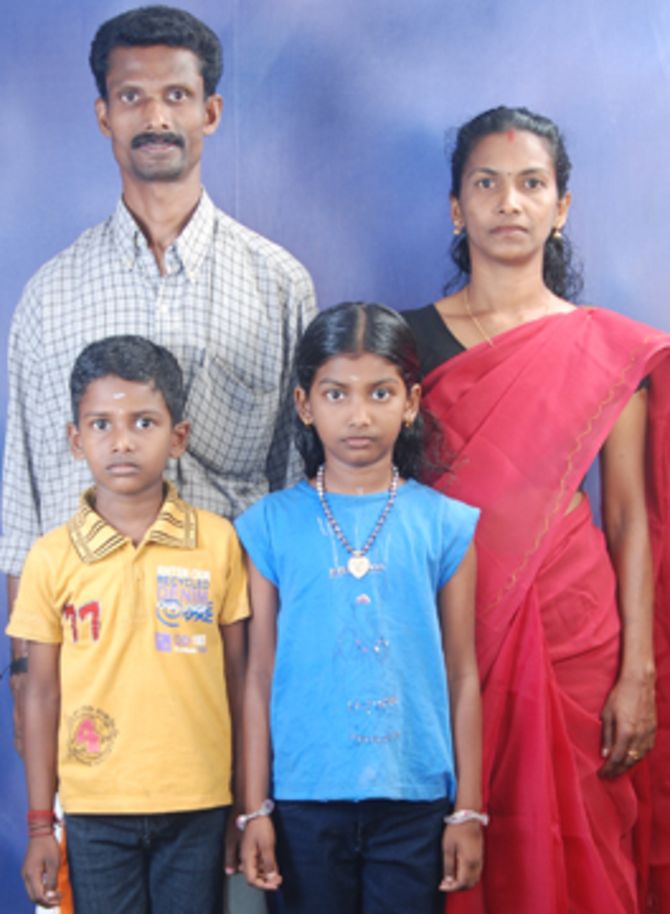Kottayam, a town in south-west India Jayan and Shylaha live here with their two children Vrundha and Ambady. Their quarter, Vellore, is a huge slum area, overpopulated with many families living at very close quarters and almost all of them work as day labourers.
The meagre wages which father Jayan brings home in the evenings have to suffice for the next day. The principle here is from hand to mouth. But one day Jayan couldn’t go to work. He was weak, couldn’t get up and was coughing and a fever tortured his body. “We were terribly worried,” his wife, Shylaha, says.
“First my husband, and now the children” mother Shylaha lamented. But the two little ones bravely took their medicine regularly. Photo: DAHW India
The staff at DAHW were able to dispel her worries: “They took Jayan to the infirmary to be examined. After the examinations it was definite that he had tuberculosis.” But this worry did not last long because the teams are quick to inform the family and neighbours about the disease and its treatment. Jayaraman Ravichandran, DAHW representatives in India says: “We don’t just heal the disease we also take away the anxiety of the people surrounding our patients.”
The Indian DAHW teams always test relatives and neighbours of new patients. This is the only way they can prevent the lethal disease from spreading even faster. And they make checks that the medicine is being taken regularly: if it is not taken until the disease has been completely cured, the surviving bacteria form resistances. This multi-resistant TB (MDR-TB) is extremely difficult to treat and gives rise to enormous costs: up to 50 times more expensive than normal therapy. “This is why we visit the family often, encouraging them and giving them security.” Japamala Bhavan, an on-site DAHW staff member, says. “One time we were visiting we discovered conspicuous symptoms in the children. They were coughing badly. The two little ones were examined; they had caught tuberculosis.
At last normal family life came back to them. Photo: DAHW India
Their mother, Shylaha was distraught: “First my husband and now the children,” she stammered. Tears were running down her face. Bhavan and his colleagues took care of the frantic wife and soothed her. They assured her that they could and would help her children by means of an effective treatment. From this time on they visited the family three times a week bringing medicine and hope with them.
At last the first big day comes: Father Jayan has a negative result in the TB test; he is well again. Neighbours and friends share the family’s joy. And later, at the end of their treatment, the children are cured of the disease. “The four of them still visit us occasionally,” Japamala Bhavan tells us, “and they thank us every time for helping so that today they are all well.”
Change of location: Hyderabad in the federal state of Andhra Pradesh
Almost 900 kilometres away from Kottayam. DAHW teams are at work here too. One of them discovered 13 year-old orphan, Sherly, in the Kukatpally slum area. The only information was that the mother had spit blood shortly before she died. Consequently the helpers suspected that she had TB.
The girl was poorly. She was struggling because of the loss of her parents; her weak body was racked by daily fits of coughing. In the Sivananda hospital multi-resistant TB bacteria were finally found. “The little one was in great danger,” says Nuthan, the director of the orphanage on the hospital grounds.
The fact that Sherly now lives here ultimately saved her life because DAHW also works in the hospital which it has been supporting for many years. It meant that the staff soon saw that the treatment was working: “After twelve days her condition had perceptibly improved,” says Nuthan, “and her appetite had also increased.”
Sherly is brave. She managed to finally overcome her TB in spite of her fear of injections. Photo: DAHW India
The health assistants explained to the 13 year-old how vital her treatment was, and also how important protection against infection is: “Each time she has a fit of coughing she covers her mouth and nose to protect the people around her." The director of the home is clearly proud of the girl under his care. “It’s not easy for her, especially as she has to carry on strictly with the MDR-TB treatment for 24 months.”
Sherly shyly points to the spot where the injection with the vital antibiotic pierces the skin. “I’m always afraid of the needle. The injection hurts me a lot.” But she smiles courageously and that makes the members of the DAHW staff happy to see how Sherly can develop into a healthy teenager with her help.
And she is already creating the first goals for her life: “When I’m healthy again I want to go back to school." Luckily it is right next to the hospital and she is allowed to go there as soon as she is no longer infectious.



